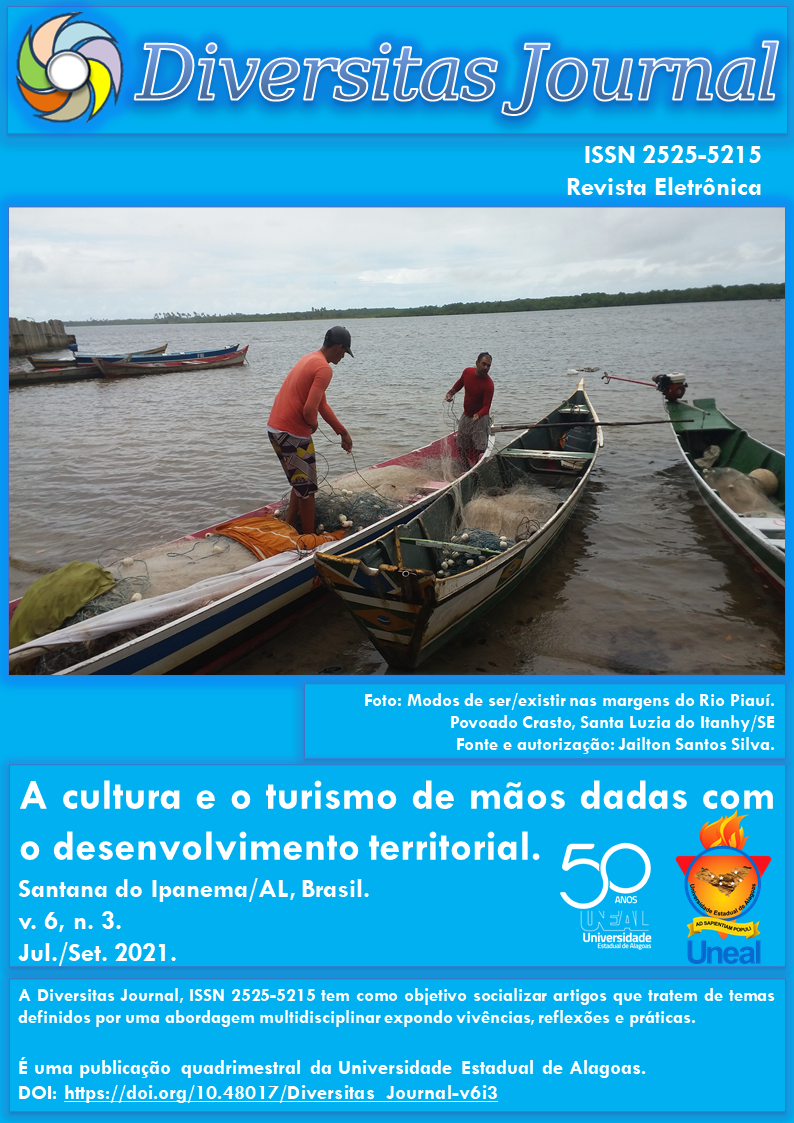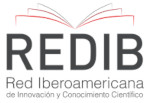Caraterísticas agronômicas de plantas de rabanete (Raphanus sativus L.) cultivadas sob diferentes fontes de adubos orgânicos
DOI:
https://doi.org/10.48017/Diversitas_Journal-v6i3-1454Resumo
RESUMO: O cultivo do rabanete (Raphanus sativus L.) tem sido orientado principalmente pela agricultura familiar, a qual demanda sobremaneira estratégias mais econômicas e sustentáveis e, neste caso, o uso de fertilizantes orgânicos tem sido uma ferramenta fundamental frente ao incremento da produtividade e melhorias quanto à qualidade da produção. O objetivo da pesquisa foi analisar as características agronômicas relacionadas à altura, diâmetro de colo e o número de folhas de plantas de R. sativus cultivadas sob diferentes fontes de adubação orgânica. O experimento foi conduzido nas dependências da Universidade de Araraquara (UNIARA), composto por quatro tratamentos e seis repetições, em um delineamento em blocos casualizados, sendo caracterizados por um controle (ausente de adubação) (T1), e por três fontes de adubos orgânicos: esterco bovino curtido (20 %) (T2), composto vegetal (20 %) (T3) e húmus de minhoca (20 %) (T4). Os parâmetros analisados foram a altura média das plantas (cm), diâmetro médio do colo (mm), e número médio de folhas (n), sendo as avaliações conduzidas aos 35 e 50 dias após semeadura. A adubação orgânica à base de húmus de minhoca propiciou incremento significativo em relação ao controle no que compete à altura de plantas aos 35 e 50 dias após semeadura, com resultados positivos e significativos frente ao diâmetro de colo aos 50 dias após semeadura. O fertilizante orgânico caracterizado pelo esterco bovino propiciou maior altura de plantas de R. sativus aos 50 dias após semeadura, quando comparado ao controle, enquanto o composto vegetal não auxiliou frente ao desenvolvimento da cultura no que compete às características agronômicas analisadas. O adubo orgânico relacionado a húmus de minhoca, à concentração de 20%, auxilia no crescimento e desenvolvimento de plantas de rabanete, principalmente no que tange as características agronômicas, altura e diâmetro de colo, enquanto o esterco bovino proporciona maior crescimento de plantas de R. sativus.
PALAVRAS-CHAVE: horticultura, fertilizantes, crescimento, rabanete.
Métricas
Referências
ALGERI, A.; LUCHESE, A. V.; SATO, A. J. Dejeto de aves e suínos no cultivo do rabanete. Revista em Agronegócio e Meio Ambiente, v. 13, n. 3, p. 933-946, 2020.
ALMEIDA, U. O. Características agronômicas do rabanete submetido a diferentes substratos preparados com coprólitos de minhoca. Agropecuária Científica no Semiárido, v. 15, n. 4, p. 281-286, 2019.
ARAÚJO, R. G. V.; LIMA, J. R. B.; SILVA, A. B.; SANTOS, G. T.; SILVA, J. M.; PAES, R. A. Desenvolvimento de tubérculos de rabanete em função de diferentes concentrações de húmus de minhoca. Ciência Agrícola, v. 18, n. 3, p. 1-5, 2020.
BASHA, D. M. R.A.; EL-AILA, H. I. Response of foliar spraying with amino acids and integrated use of nitrogen fertilizer on radish (Raphanus sativus L.) plant. International Journal of ChemTech Research, v. 8,n. 11, p. 135-140, 2015.
BASÍLIO, A. G. S.; SOUSA, L. V.; SILVA, T. I.; MOURA, J. G.; GONÇALVES, A. C. M.; MELO FILHO, J. S.; LEAL, Y. H.; DIAS, T. J. Radish (Raphanus sativus L.) morphophysiology under salinity stress and ascorbic acid treatments. Agronomía Colombiana, v. 36, n. 3, p. 257-265, 2018.
BERILLI, S. S.; CAZAROTI, E. F.; MOREIRA, R. M. G.; SALES, R. M.; BERILLI, A. P. C. G. Lodo de curtume como adubo alternativo na produção de rabanete. Energia na Agricultura, v. 35, n. 2, p. 214-224, 2020.
BONELA, G. D.; SANTOS, W. P.; SOBRINHO, E. A.; GOMES, E. J. C. Produtividade e qualidade de raízes de rabanete cultivadas sob diferentes fontes residuais de matéria orgânica. Revista Brasileira de Agropecuária Sustentável, v. 7, n. 2, p 66-74, 2017.
CASTRO, B. F.; SANTOS, L. G.; BRITO, C. F. B.; FONSECA, V. A.; BEBÉ, F. V. Produção de rabanete em função da adubação potássica e com diferentes fontes de nitrogênio. Revista de Ciências Agrárias, v. 39, n. 3, p. 341-348, 2016.
CECCONELLO, S. T.; CENTENO, L. N. Avaliação de diferentes dosagens de vermi composto produzido a partir de frutas, legumes e verduras na produção de rabanete (Raphanus sativus L.). Revista Tema, v. 13, n. 1, p. 93-102, 2016.
CERQUEIRA, F. B.; SANTANA, S. C.; SANTOS, W. F.; FREITAS, G. A.; NUNES, T. V.; SIEBENEICHLER, S. C. Doses de nitrogênio nas respostas morfofisiológicas de coentro (Coriandrum sativum L.). Global Science Technology,v. 9, n. 1, p. 15-21, 2016.
EMBRAPA. Sistema brasileiro de classificação dos solos. Brasília: Embrapa. 2013.
FERREIRA, D. F. Sisvar: a guide for its bootstrap procedures in multiple comparisons. Ciência e Agrotecnologia, v. 38, n. 2, p. 109-112, 2014.
LANNA, N. B. L.; SILVA, P. N. L.; COLOMBARI, L. F.; CORRÊA, C. V.; CARDOSO, A. I. I. Residual effect of organic fertilization on radish production. Horticultura Brasileira, v. 36, n. 1, p. 47-53, 2018.
LINHARES, P. C. F.; PEREIRA, M. F. S.; PAZ, A. E. S.; PAIVA, A. C. C.; BEZERRA, A. K. H.; FERNANDES, P. L. O. Efeito residual de espécies espontâneas da caatinga no desempenho agronômico do coentro. Cadernos de Agroecologia, v. 6, n. 2, p. 1-5, 2011.
LOPES, H. L. S.; SAMPAIO, A. S. O; SOUZA, A. C. P.; LIMA, D. C.; SOUTO, L. S.; SILVA, A. M.; MARACAJÁ, P. B. Crescimento inicial da cultura do rabanete (Raphanus sativusL.) submetida a níveis e fontes de fertilizantes orgânicos. Revista Brasileira de Gestão Ambiental, v. 13, n. 1, p. 19-24, 2019.
MEDEIROS, T. S.; GOMES, A. R. M. G.; ALVES, M. P. B. MARCELINO, A. S.; SANTOS, D. M. GIONGO, A. M. M. COSTA, A. R. Produção de rabanete (Raphanus sativusL.) cultivado sob níveis de esterco bovino e respiração basal do solo. Brazilian Applied Science Review, v. 3, n. 2, p. 1348-1357, 2019.
RODRIGUES, J. F.; REIS, J. M. R.; REIS, M. de A. Utilização de estercos em substituição a adubação mineral na cultura do rabanete. Revista Trópica: Ciências Agrárias e Biológicas, v. 7, n. 2, p. 160-168, 2013.
SILVA, P. F.; MATOS, R. M.; ALENCAR, A. E. V.; DANTAS JUNIOR, G. J.; DANTAS NETO, J. Respostas de plantas de rabanete a adubação orgânica. Cadernos de Agroecologia, v. 10, n. 3, p. 1-5, 2016.
SOUZA, S. R.; FONTINELE, Y. R.; SALDANHA, C. S.; ARAÚJO NETO, S.E.; KUSDRA, J. F. Produção de alface com o uso de substrato preparado com coprólitos de minhoca. Revista Ciência e Agrotecnologia,v. 32, n. 1, p. 115-121, 2008.
VILLAS BÔAS, R. L.; PASSOS, J. C.; FERNANDES, M.; BÜLL, L. T.; CEZAR, V. R. S.; GOTO, R. Efeito de doses e tipos de compostos orgânicos na produção de alface em dois solos sob ambiente protegido. Horticultura Brasileira, v. 22, n.1, p. 28-34, 2004.
Downloads
Publicado
Como Citar
Edição
Seção
Licença
Copyright (c) 2021 Antonio Wagner Pereira Lopes, César Augusto Feliciano, César Giordano Gêmero, Vera Lucia Silveira Botta Ferrante

Este trabalho está licenciado sob uma licença Creative Commons Attribution 4.0 International License.
O periodico Diversitas Journal expressa que os artigos são de unica responsabilidade dos Autores, conhecedores da legislação Brasileira e internacional. Os artigos são revisados pelos pares e devem ter o cuidado de avisar da possível incidencia de plagiarismo. Contudo o plagio é uma ação incontestavel dos autores. A Diversitas Journal não publicará artigos com indicios de Plagiarismos. Artigos com plagios serão tratados em conformidade com os procedimentos de plagiarismo COPE.
A violação dos direitos autorais constitui crime, previsto no artigo 184, do Código Penal Brasileiro:
“Art. 184 Violar direitos de autor e os que lhe são conexos: Pena – detenção, de 3 (três) meses a 1 (um) ano, ou multa. § 1o Se a violação consistir em reprodução total ou parcial, com intuito de lucro direto ou indireto, por qualquer meio ou processo, de obra intelectual, interpretação, execução ou fonograma, sem autorização expressa do autor, do artista intérprete ou executante, do produtor, conforme o caso, ou de quem os represente: Pena – reclusão, de 2 (dois) a 4 (quatro) anos, e multa.”


















